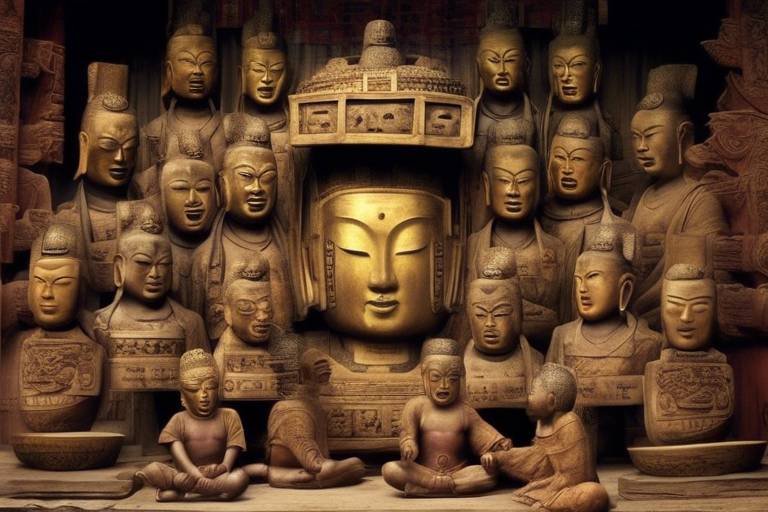The Symbolism of Colors in Ancient Cultures
Exploring the significance and meanings of colors in ancient civilizations reveals a fascinating tapestry of cultural beliefs and practices. Colors were not merely used for aesthetic purposes but held deep symbolic value, influencing rituals, art, and daily life in profound ways.

Egyptian Symbolism
Delving into the fascinating world of Egyptian symbolism reveals a rich tapestry of colors deeply intertwined with religious and cultural significance. In ancient Egypt, colors were not merely aesthetic choices but held profound meanings that permeated every aspect of life. Blue, symbolizing the Nile River and the sky, represented fertility and rebirth. The vibrant hue of red signified vitality, power, and the life-giving properties of blood. Gold, associated with the sun god Ra, symbolized divinity, eternity, and the pharaoh's authority.

Greek and Roman Perspectives
When delving into the color symbolism of ancient Greece and Rome, one can uncover a rich tapestry of meanings and associations that influenced various aspects of society. In these civilizations, colors held significant symbolic value, shaping art, fashion, and even religious beliefs. White, often associated with purity and divinity, was a prominent color in both Greek and Roman cultures. It represented clarity, innocence, and the divine presence, often seen in the garments of gods and goddesses.
On the other hand, purple held a special status in these ancient societies, symbolizing royalty, power, and wealth. Reserved for the elite and rulers, purple garments signified authority and prestige. Black, a color often linked to mourning and death in modern times, carried different connotations in Greek and Roman perspectives. It represented strength, formality, and sophistication, frequently used in attire for formal occasions and important events.
Furthermore, the use of colors in art and architecture reflected the cultural values and beliefs of the Greeks and Romans. Vibrant mosaics, intricate frescoes, and detailed sculptures showcased the significance of color in conveying narratives and expressing emotions. The careful selection of hues and shades added depth and meaning to artistic creations, capturing the essence of life and mythology in vivid detail.
When examining the role of colors in fashion, it becomes evident that ancient Greek and Roman societies valued aesthetics and symbolism in their attire. The choice of colors in clothing not only reflected social status but also conveyed messages about identity and cultural norms. From elaborate togas to intricately designed robes, the use of color in garments was a way to communicate one's position in society and adherence to traditions.
In conclusion, the symbolism of colors in ancient Greek and Roman cultures transcended mere aesthetics, playing a vital role in shaping beliefs, practices, and societal structures. By understanding the significance of colors such as white, purple, and black in these civilizations, we gain insight into the intricate tapestry of meanings woven into the fabric of history.

Chinese Color Symbolism
Exploring the significance and meanings of colors in ancient civilizations, shedding light on how different cultures interpreted and used colors in rituals, art, and daily life.
Delving into the color symbolism in ancient Egypt, where colors like blue, red, and gold held deep religious and cultural significance.
Understanding how colors such as white, purple, and black were symbolically used in ancient Greek and Roman societies, influencing art, fashion, and beliefs.
Examining the traditional Chinese beliefs around colors like red, yellow, and black, and their associations with luck, prosperity, and spirituality.
Exploring the diverse color symbolism in indigenous cultures worldwide, from the vibrant hues of Native American tribes to the intricate meanings in African traditions.
Unveiling the rich color symbolism in ancient Indian culture, where colors like saffron, green, and blue carried spiritual, social, and cosmic significance.
Discovering the symbolic meanings of colors in Mayan and Aztec civilizations, where colors like jade green, blood red, and royal blue held ritualistic and cultural importance.
Unraveling the color symbolism in Viking culture, where colors such as red, white, and black represented power, protection, and connection to the gods.
Investigating the color symbolism in ancient Mesopotamia, where colors like purple, white, and black were used in art, religion, and symbolism, reflecting societal values and beliefs.
In traditional Chinese culture, colors play a significant role in symbolizing various aspects of life and beliefs. Red, symbolizing luck and happiness, is commonly used in weddings and other celebratory events. Yellow, representing prosperity and royalty, was reserved for the emperor in ancient times. Black, associated with water and the north, signifies mystery and depth, often used in funerals and to ward off evil spirits. These colors are deeply ingrained in Chinese traditions and continue to hold symbolic importance in modern society.

Indigenous Cultures' Views
Indigenous cultures around the world have a deep and profound connection to colors, viewing them not just as visual stimuli but as carriers of rich symbolism and meaning. From the vibrant hues of Native American tribes to the intricate color schemes in African traditions, colors play a pivotal role in expressing cultural identity, spiritual beliefs, and societal values.
In Native American cultures, colors are often deeply intertwined with nature and the elements. The earthy tones of brown and green symbolize the connection to the land and the cycles of life, while the bright hues of red and yellow represent vitality, energy, and spiritual power. Each color carries a story, a history, and a significance that extends far beyond mere aesthetics.
Similarly, in African traditions, colors hold specific meanings that vary across different tribes and regions. For example, the color white may symbolize purity and peace in one community, while in another, it could represent mourning or spirituality. The use of intricate patterns and color combinations in clothing, body art, and ceremonial objects reflects the complex tapestry of beliefs and customs within indigenous societies.
Moreover, colors in indigenous cultures are often used in rituals, ceremonies, and storytelling to convey deep-rooted messages and teachings. The choice of colors in traditional attire, masks, and symbolic objects serves as a visual language that communicates ancestral wisdom, cultural heritage, and community values.
Exploring the color symbolism in indigenous cultures unveils a world where every shade, tint, and hue carries significance beyond the visible spectrum. It is a world where colors are not just colors but gateways to understanding the complexities of human experience, spirituality, and interconnectedness with the natural world.

Indian Color Symbolism
Exploring the significance and meanings of colors in ancient civilizations, shedding light on how different cultures interpreted and used colors in rituals, art, and daily life.
Delving into the color symbolism in ancient Egypt, where colors like blue, red, and gold held deep religious and cultural significance.
Understanding how colors such as white, purple, and black were symbolically used in ancient Greek and Roman societies, influencing art, fashion, and beliefs.
Examining the traditional Chinese beliefs around colors like red, yellow, and black, and their associations with luck, prosperity, and spirituality.
Exploring the diverse color symbolism in indigenous cultures worldwide, from the vibrant hues of Native American tribes to the intricate meanings in African traditions.
Unveiling the rich color symbolism in ancient Indian culture, where colors like saffron, green, and blue carried spiritual, social, and cosmic significance.

Mayan and Aztec Color Meanings
Exploring the significance and meanings of colors in ancient civilizations, shedding light on how different cultures interpreted and used colors in rituals, art, and daily life.
Delving into the color symbolism in ancient Egypt, where colors like blue, red, and gold held deep religious and cultural significance.
Understanding how colors such as white, purple, and black were symbolically used in ancient Greek and Roman societies, influencing art, fashion, and beliefs.
Examining the traditional Chinese beliefs around colors like red, yellow, and black, and their associations with luck, prosperity, and spirituality.
Exploring the diverse color symbolism in indigenous cultures worldwide, from the vibrant hues of Native American tribes to the intricate meanings in African traditions.
Unveiling the rich color symbolism in ancient Indian culture, where colors like saffron, green, and blue carried spiritual, social, and cosmic significance.
Discovering the symbolic meanings of colors in Mayan and Aztec civilizations, where colors like jade green, blood red, and royal blue held ritualistic and cultural importance.
Unraveling the color symbolism in Viking culture, where colors such as red, white, and black represented power, protection, and connection to the gods.
Investigating the color symbolism in ancient Mesopotamia, where colors like purple, white, and black were used in art, religion, and symbolism, reflecting societal values and beliefs.

Viking Color Symbolism
When delving into the world of Viking color symbolism, we uncover a rich tapestry of meanings and significance attached to different hues. In Viking culture, colors were not merely aesthetic choices but carried deep symbolic weight, reflecting beliefs, values, and connections to the divine. The colors prominently featured in Viking art, clothing, and rituals were red, white, and black.
Red: Symbolizing power, passion, and vitality, red held a central place in Viking color symbolism. It represented the fierce energy of warfare, the strength of bloodlines, and the intensity of life itself. Red was often associated with courage and honor, qualities highly revered in Viking society.
White: In Viking culture, white symbolized purity, innocence, and the divine. It was linked to concepts of cleanliness, clarity, and spiritual enlightenment. White was also seen as a color of protection, warding off evil spirits and bringing blessings from the gods.
Black: Representing mystery, strength, and resilience, black was a significant color in Viking symbolism. It denoted the depths of the unknown, the power of the underworld, and the inevitability of fate. Black was often used in funerary rites and rituals related to the afterlife.
Just as each color had its unique symbolism, the combination of colors in Viking art and artifacts also conveyed intricate meanings. The interplay of red, white, and black in intricate patterns and designs spoke volumes about the interconnectedness of life, death, and the divine forces that governed the Viking worldview.
Exploring Viking color symbolism offers a fascinating glimpse into the intricate belief systems and cultural practices of this ancient seafaring people. By understanding the meanings behind the colors they revered, we gain a deeper appreciation for the rich tapestry of symbolism that colored every aspect of Viking life.

Ancient Mesopotamian Views
Ancient Mesopotamian Views delved deep into the symbolism of colors, where each hue carried profound meanings and significance. In this ancient civilization, purple was associated with royalty and power, symbolizing the authority of rulers and gods. White represented purity and divinity, often used in religious ceremonies and art to depict the divine presence. Black held dual meanings of fertility and death, reflecting the cycle of life and the underworld in Mesopotamian beliefs.
Frequently Asked Questions
- What is the significance of colors in ancient cultures?
Colors in ancient cultures held deep symbolic meanings and were often associated with religious beliefs, social status, and cosmic elements. They were used in rituals, art, and daily life to convey messages and express cultural values.
- How did different ancient civilizations interpret colors?
Ancient civilizations like the Egyptians, Greeks, Romans, Chinese, Mayans, Aztecs, Vikings, and Mesopotamians had unique interpretations of colors. For example, red symbolized power in some cultures while representing luck in others, showcasing the diverse meanings attached to colors.
- What role did color symbolism play in art and spirituality?
Color symbolism played a crucial role in ancient art, influencing the choice of colors in paintings, sculptures, and architecture. In spirituality, colors were believed to have healing properties and were used in rituals to connect with the divine or evoke specific energies.
- How did colors impact daily life in ancient societies?
Colors influenced various aspects of daily life in ancient societies, from the clothes people wore to the decorations in their homes. Certain colors were reserved for specific occasions or individuals, reflecting social norms and cultural traditions.



















